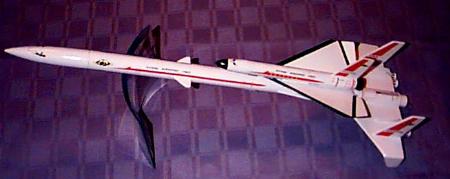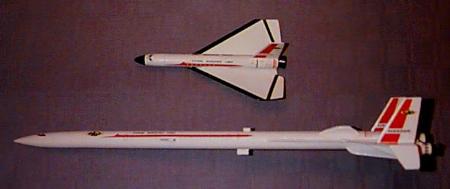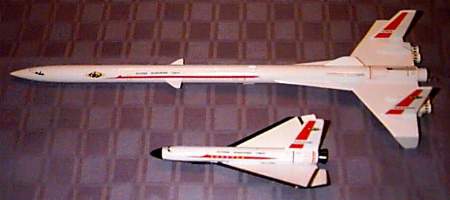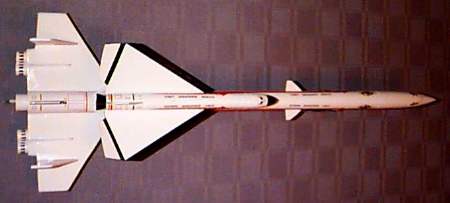Clone Astron Orbital Transport Clone
Clone - Estes Orbital Transport {Scratch}
Contributed by Martin Visnak
| Construction Rating: | starstarstarstarstar_border |
| Flight Rating: | starstarstarstarstar_border |
| Overall Rating: | starstarstarstarstar |
| Published: | 2010-11-12 |
| Manufacturer: | Clone |
| Style: | Clone, Futuristic/Exotic |
Brief:
Fantasy/Futuristic Boost Glider.

Construction:
The original Estes Orbital Transport kit has been out of production for a number of years. I would guess finding an original complete, unbuilt kit would be next to impossible today. If one were to find one I am sure they would pay dearly for it! This review is based on building a "clone" of the original Orbital Transport kit. I made every effort to duplicate the original kit both in parts collection and construction. I used a copy of the original plans from Jim Z's web site and replicated decals from Tango Papa Decals. I used the nose cones from my original kit purchased 27 years ago; all other components were readily available Estes parts. New balsa nose cones of the same original dimensions, may be purchase from Balsa Machining Services. Please see addresses for all of these vendors later in the review.

Finishing:
Since this is a clone kit the first thing you will need to do is get the plans from Jim's web site. The next step is to collect the parts listed in the plans. The parts list is easy to fill, but you will need some Estes part number translation in order to get the proper lengths of tubing. For the listed BT-20D (the body tube for the glider), use a 6 1/2" length of BT-20. The parts also included 4 BT-5T tubes that are used as the Scam Jet engines. These are nothing more than BT-5 body tubes in 1 1/2" lengths. The two balsa nose cones, BNC-50Y and BNC-20B are obtainable through Balsa Machining Services. The fin stock is standard Estes balsa. BFS-30L is 3/32" x 3" x 12" and BFS-20L is 1/16" x 3" x 12" in dimension. Of course any 3/32" and 1/16" balsa stock may be used. The Decal sheet is obtainable from either Jim Zalewski or Tom Baker at Tango Papa Decals (see resources below).
I might suggest upgrading from the stock Estes 18" plastic parachute to a cloth chute. If you are handy on a sewing machine you could make one yourself or they are easily purchased at a number of places. Be careful however, in your chute material choice, as the BT-50 body tube is not very roomy. Thin mill ripstop nylon would be preferred.
The original Estes instructions are very detailed and relatively easy to follow. Despite it's simple lines, I would say that the Orbital transport is a difficult kit to build (and even more difficult to make look really good). Estes assigned a "Skill Level 4" to the kit, which was translated as "advanced" in their rating structure. The wings of the booster and glider, are composites of multiple balsa parts that are pieced together in stages. The original kit did not have the convenience of diecut fin parts. The builder had to cut out the paper pattern, trace the pattern on the balsa stock and then cut the fin pieces out using a sharp X-acto knife. When you proceed with cutting out the various fin/wing parts pay close attention to the grain of the balsa as compared to the templates. The templates do show grain direction and the balsa parts should be cut out with the grain in the correct orientation to achieve maximum strength from the completed wings.

There are two templates in the pattern sheet that the builder would do best to modify. Those two templates are the "elevation guide" and the "booster wing alignment template". I suggest cutting these two templates out and gluing them to heavy card stock. Let the glue dry, then trim the card stock away so that only the template outline remains. This gives the templates rigidity and makes them much easier to use. If any of you are like me and usually just build a kit with little regard to the directions I suggest modifying your behavior for this kit. The directions are detailed and reading through the steps prior to actually performing the building will help you get a nicer model and become less frustrated while building.
I suggest the final coat of paint (after a good coat of primer) be of the epoxy based kind. The suggested color by Estes is gloss white. Rust-Oleum makes a gloss white "Appliance Enamel" that is epoxy based and the finished product is nothing short of spectacular. The epoxy paint leaves a very shiny bright finish and this paint fills small imperfections, like balsa grain, very well! The scam jet engines are mounted in sets of twos under each wing of the booster. On close inspection of the photo/art provided by Estes (also check out an old catalog if you have one) one will see that the Estes folks filled the spaces between the scram jet engines (the BT-5 tubes). I did not fill this area in my model however, the really detail minded builder might consider this additional task not listed in the instructions. The glider should be very carefully built and painted the then glide characteristics should be tested. A series of gentle tosses should tell you if and where you will need to add weight. I had to add nose weight to my glider. I used a small blob of modeler's clay and placed it just forward of the "hook" the glider uses to attach to the mothership. You might also wish to hollow out the nose cone of the glider and place ballast in the cavity prior to gluing the nose onto the glider. I prefer the outside attachment of ballast as it enables me to add or subtract weight as glide characteristics change. The blob of clay I needed was quite small and did not detract from the finished appearance of the model in the least. I also adjusted the elevons of the glider such that one was slightly "higher" than the other was, so that the glider flew in a circular path. This makes recovery much less of a walk.

Construction Rating: 4 out of 5
Flight:
The finished model flies arrow straight with a slight twist (about 3/4 of a revolution by apogee), the model then noses over at apogee and waits for the ejection charge to fire. At ejection, the parasitic glider is dislodged from it's perch on the mothership's back and down they both come. The recommended engines for this kit are B6-2, B6-4 and C6-5, with the B6-4 listed as the first flight engine. I personally think the B6-4 does not get your "labor of love" to a lofty enough attitude and recommend the C6-5 exclusively. I have also launched this kit on C6-3 motors with good success.
Recovery:
The booster has recovered well for me with no damages at all. The 18" parachute I used is a Top Flight Recovery thin mill Nylon chute. Since it is Nylon, packing this chute needs to be done carefully as it takes up more room than the plastic chutes. I also used a Pratt Hobby Nomex heat protector in place of recovery wadding to great success. One might also wish to use a Kevlar shock cord mount that is attached to the motor mount rather than, the suggested folded paper mount found on most Estes kits. If you decide to make the Kevlar shock cord mount do not forget to add this step into the building of the clone at the engine mount gluing phase (step 13 in the instructions). The glider is trimmed almost perfectly and it returns to earth in a gentle spiral, landing very softly.
Flight Rating: 4 out of 5
Summary:
I would give this kit a 5 for overall satisfaction. I have to mention that this kit really holds a special place in my heart so my rating is admittedly biased.
Resources:
Pratt Hobbies
2513 Iron Forge Road
Herndon, VA 20171
(703) 689-3514
Tango Papa Decals
Tom Prestia
3103 Broadway Road
Easton, PA 18040
Bill & Mary Ann Saindon
Balsa Machining Service
11995 Hillcrest Drive
Lemont, IL 60439
(630)257-5420
Jim Fackert and Al DeLaIglesia
Totally Tubular Al DelaIglesia
112 Cranbrook
Howell MI 48843
Fax 810-231-1631
phone day: 810-231-1631 ext. 215 eve. 810-231-3471
Estes Industries
(719) 372-6565
Estes Customer Service
(800)525-7561
Top Flight Recovery
S12621 Donald Road
Spring Green, WI 53588
(608) 588-7240
Overall Rating: 5 out of 5
Other:
The clone I built has had numerous launches, all of which had good recoveries with little or no damage to either glider or booster. This kit is a real crowd pleaser and I find that if you want to meet "old timers" walking this bird to the pad will draw them out of the group like a magnet. As a boy I would leaf through the pages of my coveted Estes catalog and with only a few possible exceptions such as of the Trident, the interceptor or the Mars Lander, the Orbital Transport was the most desirable. Now as an adult who owns 10's of completed rockets I still count the Orbital Transport as a favorite. I wish anyone whom takes on this project good luck and good memories if you are an "old timer" or BAR. The effort is worth the result. I would also like to thank the number of people that have put in a lot of hard work making the parts and plans for the older Estes kits available again.
#Related Reviews
Related Products
 |
 |
Sponsored Ads
 |
 |












John R, Brandon III (May 27, 2011)
Update! Semroc will sell you a kit for this bird with a couple of minor improvements (it's in their Retro-Repro series).